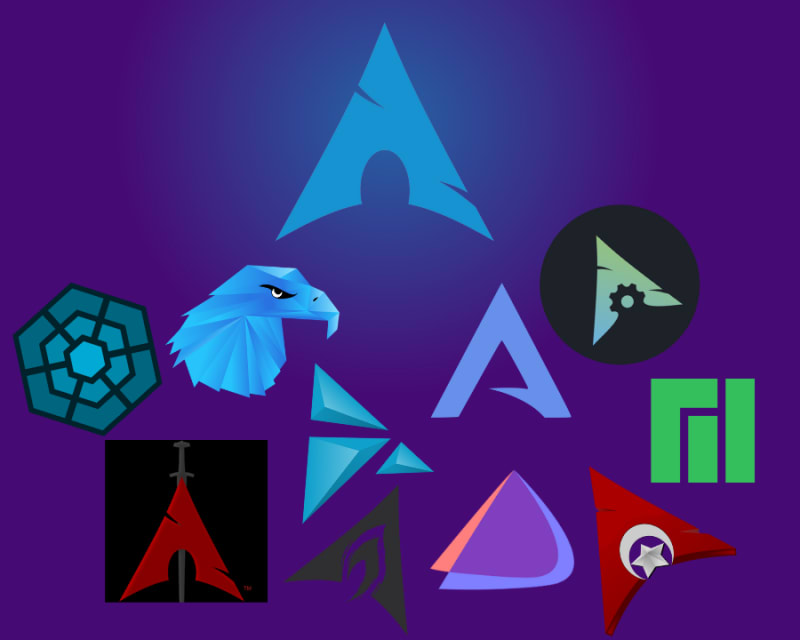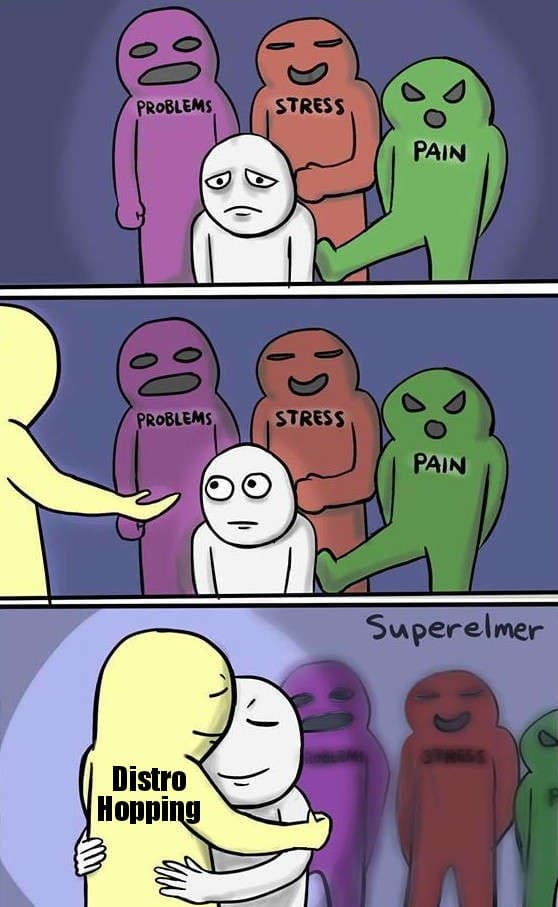There are a lot, a loooot of Linux distros out there. However, there are mainly 3 types for distros for general people, Debian based distros, Arch based distros & Fedora based distros. I have tried all these three kinds of distros on my Laptop & here I am sharing my experience.
My Laptop
Firstly let me give you a brief about my laptop. I have a HP Victus laptop. It has 8gb RAM, 512gb SSD, Intel i5 11th Gen & NVidia 1650 ti graphics card.
My distro hoping journey
Till now I have switched a lot of distros on this laptop. It initially came with Windows 11 out of the box, however, me being a Linux lover, wanted to install Linux on it.
So I installed KDE neon(Debian based) on it in dual boot mode since I had used debian previously. Then I clean installed KDE neon. It was working reasonably well, however NVidia Graphics card was causing a lot of trouble to me. My HDMI port wasn't working since it was directly linked to my graphics card.
So I switched to PopOS!. I switched because it had good NVidia drivers support out of the box. And it worked fine, my HDMI port was finally working. However, I had encountered a lot of bugs & battery issues in it which degraded my experience over time.
So I decided to make another switch. This time, I decided to switch to a Arch Based distro. But I knew that installing Arch directly would be a lot for me, so I thought to go with a Arch based distro like Garuda Linux. So I installed it.
However after installing, my laptop wasn't booting. So I asked about it in the Garuda forum & got a quick fix that I needed to edit some grub config. So I edited it exactly the same way, and this time, it was working smoothly. However, my HDMI port still wasn't working. To use the Laptop in hybrid mode, we usually use optimus in Linux. But there was some issue with optimus on my laptop & hence I could make it work. So to use an application using Graphics card, I needed to run it using the prime-run command everytime.
After some time, I decided to make the switch again. This time, I decided to go with Nobara (Fedora based)
I specifically chose Nobara as it was gaming focused and included some modification over base fedora. And till now it has been working perfectly. Now let me tell you about my experience with all three types of distros.
Debian based distros
(My experience from: Ubuntu, Kubuntu, KDE Neon & PopOS!)

Debian based distros are generally the first Linux distro anyone uses. And that is for a reason, its very beginner friendly. Almost everything can be done easily using GUIs.
However, I faced a couple of issues on it. Firstly I have faced dependency issues multiple times. The apt package manager has given me trouble a lot of time, and most Debian based distros are actually based on Ubuntu & follow Ubuntu release cycle. Which means we get an LTS version every 2 years & non LTS version every 6 months. Which mean that we usually get older & outdated packages.
Arch based distros
(My experience from Garuda & Endeavour Linux)

Arch based distros are generally for advance users as Arch gives full control over the system. The main benefit of it is the availability of softwares. Everything is available in AUR. It is the most cutting edge distro with the latest softwares. One con that it has is that when tinkering a bit, you can break some stuff, & to fix that you need to be a little tech savy. And I found it a bit buggy as well.
Fedora based distros
(Me experience from Nobara Linux)

Fedora is my current favourite. It is very stable. And I have faced the least amount of bugs till now. Fedora uses a 6 month release cycle & hence we get a perfect balance between stable, well tested packages & cutting edge softwares. As for the con, I couldn't really find any, however, if I had to nitpick , it would be that the maximum number of softwares online are packaged in deb format which is only supported on linux. however, till dates I have not come across any packages that isn't available on Fedora. However, installing base Fedora has a bit of extra steps after installing. So I prefer Nobara.
A special note on Distrobox
If you want to install packages from other distros, you can use distrobox, it basically utilizes podman behind the scenes. You can refer to this itsfoss article for more info: https://itsfoss.com/distrobox/
My conclusion
So if you are a beginner, you can go with any Debian based distro or Nobara. And if you are an advance Linux user & love to tinker around with OS and want the latest packages, prefer Arch. And if you are looking for a stable distro, go with Fedora based (I would suggest Nobara) distros.




Top comments (7)
From the perspective development, arch not only has the latest upstream packages, but also applies the fewest possible patches. This makes it easy to develop and integrate with everyone else's latest code when you need to do so. From an enterprise software testing perspective, rolling distros can be nightmares of unreproducible results ;).
Ya, that is also true, from developers perspective, rolling releases can be troublesome .
Thanks for the development perspective. I haven't really developed any software for linux 😅. I am a web developer.
I just wanted to share my experience from a user's point of view
Thanks for sharing your experience!
I migrated to Linux for the first time on vanilla Ubuntu.
I've got to tell you, it was a very interesting experience. Most of my current computers are older hardware, so I didn't have a lot of issues with missing drivers or anything.
I have distro hopped at least a couple of times. I've used Ubuntu, then Linux Mint, then Arch Linux, and found my way back to Linux Mint. It's been a very interesting experience and I'm a mostly dedicated Linux Mint user now.
It was interesting reading about your perspective on these operating systems and I can personally relate to some of the points you made, especially about the Arch systems.
Ya, Ubuntu is great too, if didn't have NVidia in my laptop, I would have sticked to it or KDE Neon & never distro hopped this much.
But I am glad I did distro hop a lot, since now I have experience many distros & know the pros & cons of each
Interesting.
I had Distro hopped recently too (MXLinux [my primary os for more than 3 years, still counting], Fedora, Cachy OS, Endeavor OS, Zorin OS, Peppermint, LMDE, Garuda Linux, etc.). I was lucky to have basic things covered, say my wifi works, display works, etc [May be because, my laptop has some Intel graphics and Nvidia graphics. An MSI G65 series Laptop].
I'm now comfortable with Fedora and Arch Linux to some extend. But, very long time Debian based user. In my experience, apt issues are not that common (Driver issues are common in any OS, even Windows have some driver nightmares, if you never noticed it, try upgrading to Windows 12 when MS release it.).
Also, Debian family can be considered Debian Family (LMDE, Peppermint comes under this) and Ubuntu Family (Linux Mint, Zorin, etc) separate too. Check distrowatch.com/ to find those family matters :-)
And regarding Nobara. It's in my list for sure.